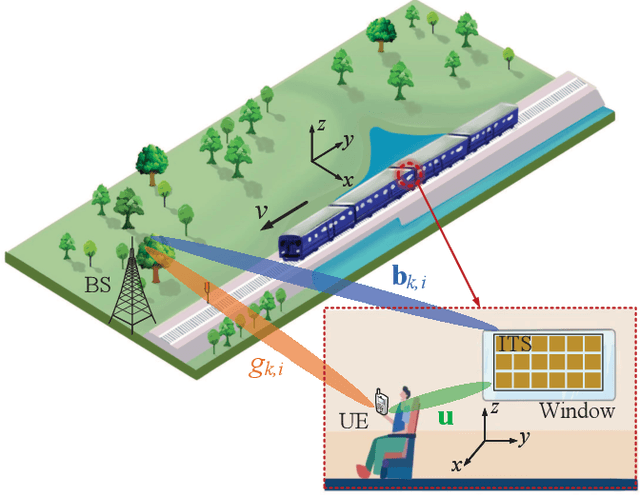Gongpu Wang
Structured Tensor Decomposition Based Channel Estimation and Double Refinements for Active RIS Empowered Broadband Systems
Nov 25, 2024Abstract:Channel parameter estimation is crucial for optimal designs of next-generation reconfigurable intelligent surface (RIS)-empowered communications and sensing. Tensor-based mechanisms are particularly effective, capturing the multi-dimensional nature of wireless channels, especially in scenarios where RIS integrates with multiple-antenna devices. However, existing studies assume either a line-of-sight (LOS) scenario or a blocked condition for non-RIS channel. This paper solves a novel problem: tensor-based channel parameter recovery for active RIS-aided multiple-antenna wideband connections in a multipath environment with non-RIS paths. System settings are customized to construct the received signals as a fifth-order canonical polyadic (CP) tensor. Four of the five-factor matrices unfortunately contain redundant columns, and the remaining one is a Vandermonde matrix, which fails to satisfy the Kruskal condition for tensor decomposition uniqueness. To address this issue, spatial smoothing and Vandermonde structured CP decomposition (VSCPD) are applied, making the tensor factorization problem solvable and providing a relaxed general uniqueness condition. A sequential triple-stage channel estimation framework is proposed based on the factor estimates. The first stage enables multipath identification and algebraic coarse estimation, while the following two stages offer optional successive refinements at the cost of increased complexity. The closed-form Cramer-Rao lower bound (CRLB) is derived to assess the estimation performance. Herein, the noise covariance matrix depends on multipath parameters in our active-RIS scenario. Finally, numerical results are provided to verify the effectiveness of proposed algorithms under various evaluation metrics.
Reconfigurable Intelligent Surface Assisted High-Speed Train Communications: Coverage Performance Analysis and Placement Optimization
Oct 19, 2023Abstract:Reconfigurable intelligent surface (RIS) emerges as an efficient and promising technology for the next wireless generation networks and has attracted a lot of attention owing to the capability of extending wireless coverage by reflecting signals toward targeted receivers. In this paper, we consider a RIS-assisted high-speed train (HST) communication system to enhance wireless coverage and improve coverage probability. First, coverage performance of the downlink single-input-single-output system is investigated, and the closed-form expression of coverage probability is derived. Moreover, travel distance maximization problem is formulated to facilitate RIS discrete phase design and RIS placement optimization, which is subject to coverage probability constraint. Simulation results validate that better coverage performance and higher travel distance can be achieved with deployment of RIS. The impacts of some key system parameters including transmission power, signal-to-noise ratio threshold, number of RIS elements, number of RIS quantization bits, horizontal distance between base station and RIS, and speed of HST on system performance are investigated. In addition, it is found that RIS can well improve coverage probability with limited power consumption for HST communications.
Doppler Shift and Channel Estimation for Intelligent Transparent Surface Assisted Communication Systems on High-Speed Railways
Jul 31, 2022



Abstract:The critical distinction between the emerging intelligent transparent surface (ITS) and intelligent reflection surface (IRS) is that the incident signals can penetrate the ITS instead of being reflected, which enables the ITS to combat the severe signal penetration loss for high-speed railway (HSR) wireless communications. This paper thus investigates the channel estimation problem for an ITS-assisted HSR network where the ITS is embedded into the carriage window. We first formulate the channels as functions of physical parameters, and thus transform the channel estimation into a parameter recovery problem. Next, we design the first two pilot blocks within each frame and develop a serial low-complexity channel estimation algorithm. Specifically, the channel estimates are initially obtained, and each estimate is further expressed as the sum of its perfectly known value and the estimation error. By leveraging the relationship between channels for the two pilot blocks, we recover the Doppler shifts from the channel estimates, based on which we can further acquire other channel parameters. Moreover, the Cramer-Rao lower bound (CRLB) for each parameter is derived as a performance benchmark. Finally, we provide numerical results to establish the effectiveness of our proposed estimators.
 Add to Chrome
Add to Chrome Add to Firefox
Add to Firefox Add to Edge
Add to Edge